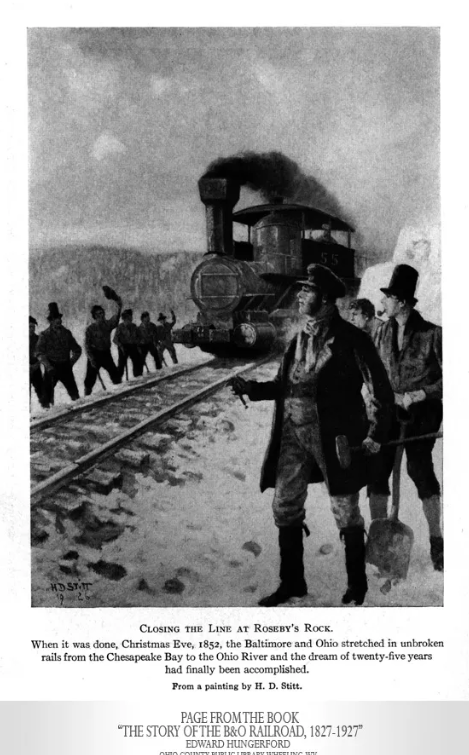On December 24, 1852, railroad workers drove the final spike connecting the Baltimore & Ohio (B&O) Railroad from Baltimore, Maryland on the East Coast to Wheeling, Virginia (now West Virginia) on the Ohio River. To commemorate the occasion, they carved an inscription ("ROSBBY'S [sic] ROCK. TRACK CLOSED CHRISTMAS EVE, 1852. HOBBS & FARIS") into the nearby 900 cubic yard Rosbys Rock sandstone formation in Marshall County, West Virginia along the railroad route. Rosbys Rock was likely named after Roseby Carr, who led B&O Railroad construction crews in the area.
There is disagreement over whether "Rosbys" is a misspelling. The spelling of the name on the rock has been a subject of debate and mystery. The craftsmen who memorialized the track closing inscribed an additional “E,” spelling the name ROSEBY’S. The mistake was somewhat altered in the painting that overlays the inscription in which the “E” has been altered as a “B,” giving the appearance of ROSBBY’S. It is unlikely that the misspelling was a careless typo, given the amount of time and labor necessary to complete such a massive carving (nearly ten feet high and 22 feet wide with letters as tall as 2 feet chiseled 2.5 inches into solid rock)
A celebration banquet, attended by over 1,000 people including dignitaries and officials, was later held on January 14, 1853 in Wheeling to celebrate the railroad linkage between the Atlantic Ocean and Ohio River Valley. The elaborate event featured speeches, musical performances, and feasting. Trains ran past Rosby's Rock from 1852 until the tracks were removed in 1974. Now just the rock itself, the small village named Rosbys Rock, and the carved inscription remain at the site as symbols of its railroad history.







 RSS Feed
RSS Feed
